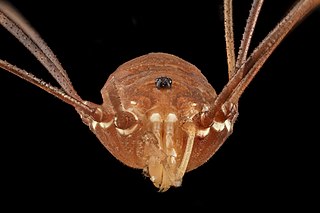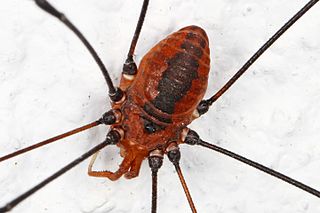
Caddo Lake is a 25,400-acre (10,300 ha) lake and bayou (wetland) on the border between Texas and Louisiana, in northern Harrison County and southern Marion County in Texas and western Caddo Parish in Louisiana. The lake is named after the Southeastern culture of Native Americans called Caddoans or Caddo, who lived in the area until their expulsion in the 19th century. It is an internationally protected wetland under the Ramsar Convention and includes one of the largest flooded cypress forests in the United States. Caddo is one of Texas's few non-oxbow natural lakes and is the second-largest in the South; however, it was artificially altered by the addition of a dam in the 1900s.

Caddo Parish is a parish located in the northwest corner of the U.S. state of Louisiana. As of the 2010 census, the population was 254,969, making it the fourth-most populous parish in Louisiana. The parish seat is Shreveport, which developed along the Red River.

The Eupnoi are a suborder of harvestmen, with more than 200 genera, and about 1,700 described species.
Caddidae is a family of harvestmen arachnids with 15 known species, the only family of the Eupnoi superfamily Caddoidea.

The agile mangabey is an Old World monkey of the white-eyelid mangabey group found in swampy forests of Central Africa in Equatorial Guinea, Cameroon, Gabon, Central African Republic, Republic of Congo, and DR Congo. Until 1978, it was considered a subspecies of the Tana River mangabey. More recently, the golden-bellied mangabey has been considered a separate species instead of a subspecies of the agile mangabey.

Caddo Mounds State Historic Site (41CE19) is an archaeological site in Weeping Mary, Texas. This Caddoan Mississippian culture site is composed of a village and ceremonial center that features two earthwork platform mounds and one burial mound. Located on an ancient Native American trail later named by the Spanish as El Camino Real de los Tejas, the settlement developed hundreds of years before the arrival of Europeans and Africans to the region. Archaeologists believe the site was created in approximately 800 CE, with most major construction taking place between 1100 and 1300 CE.
Odiellus pictus is a species of harvestman in the family Phalangiidae. It is found in North America.
Caddo is a genus of harvestmen in the family Caddidae. There are at least two described species in Caddo.
Tupiocoris agilis is a species of plant bug in the family Miridae. It is found in North America.

Vonones is a genus of armoured harvestmen in the family Cosmetidae. There are at least two described species in Vonones.

Melissodes agilis, the agile long-horned bee, is a species of long-horned bee in the family Apidae. It is found in Central America and North America.
Leiobunum ventricosum is a species of harvestman in the family Sclerosomatidae. It is found in North America.
Chrysobothris caddo is a species of metallic wood-boring beetle in the family Buprestidae. It is found in North America.
Laccobius agilis is a species of water scavenger beetle in the family Hydrophilidae. It is found in North America.

Leiobunum flavum is a species of harvestman in the family Sclerosomatidae. It is found in North America.
Leiobunum politum is a species of harvestman in the family Sclerosomatidae. It is found in North America.

Leiobunum vittatum is a species of harvestman in the family Sclerosomatidae. It is found in North America.
Leiobunum euserratipalpe is a species of harvestman in the family Sclerosomatidae. It is found in North America.
Caddo pepperella is a species of harvestman in the family Caddidae. It is found in North America.

Smitanosaurus is a genus of dicraeosaurid sauropod dinosaur from the Late Jurassic of Colorado. The genus contains one species, S. agilis, originally assigned to the defunct genus Morosaurus.









